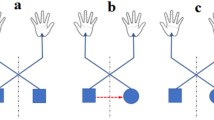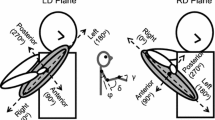Abstract
Characteristics of control at the shoulder and elbow during nine types of drawing movements were studied in the present work. The task was to repetitively track a template, depicted on a horizontal table, with the index finger at a cyclic frequency of 1.5 Hz. The templates were a circle, four ovals and four lines of different orientations. The wrist was immobilized and the movement consisted of rotations at the shoulder and elbow joints. The studied movements varied in a wide range with respect to the amplitude of elbow and shoulder movements and relative phase between them. Kinetic analysis included analysis of torque signs, impulses, and timing. It demonstrated that the role of muscle torque in movement production was different at the two joints. During eight out of the nine movement types, the muscle torque at the shoulder accelerated and decelerated this joint and almost completely coped with the influence of the interactive torque arising from elbow motion. Conversely, interactive torque generated by shoulder motion played a dominant role in elbow acceleration and deceleration, whereas muscle torque at the elbow adjusted passive elbow movement to the various template shapes. EMG data were in agreement with the conclusions made from the kinetic analysis. Collectively, these data support the hypothesis that the two joints have different functions in movement production. The shoulder creates a foundation for motion of the entire arm through the interactive torque, and the elbow serves as a fine-tuner of the end-point movement. Control of the shoulder was similar across the eight movement types and the differences in the end-point path were provided by variations in elbow control. The two joints exchanged roles during one movement type, namely, drawing the line tilted right. During this movement, the elbow musculature generated motion at this joint and the shoulder musculature counteracted mechanical influence of this motion on the shoulder position. The findings suggest that during drawing movements, the control strategy exploits intersegmental dynamics of the shoulder-elbow mechanical linkage.
Similar content being viewed by others
Author information
Authors and Affiliations
Corresponding author
Rights and permissions
About this article
Cite this article
Dounskaia, N., Ketcham, C.J. & Stelmach, G.E. Commonalities and differences in control of various drawing movements. Exp Brain Res 146, 11–25 (2002). https://doi.org/10.1007/s00221-002-1144-3
Received:
Accepted:
Published:
Issue Date:
DOI: https://doi.org/10.1007/s00221-002-1144-3




